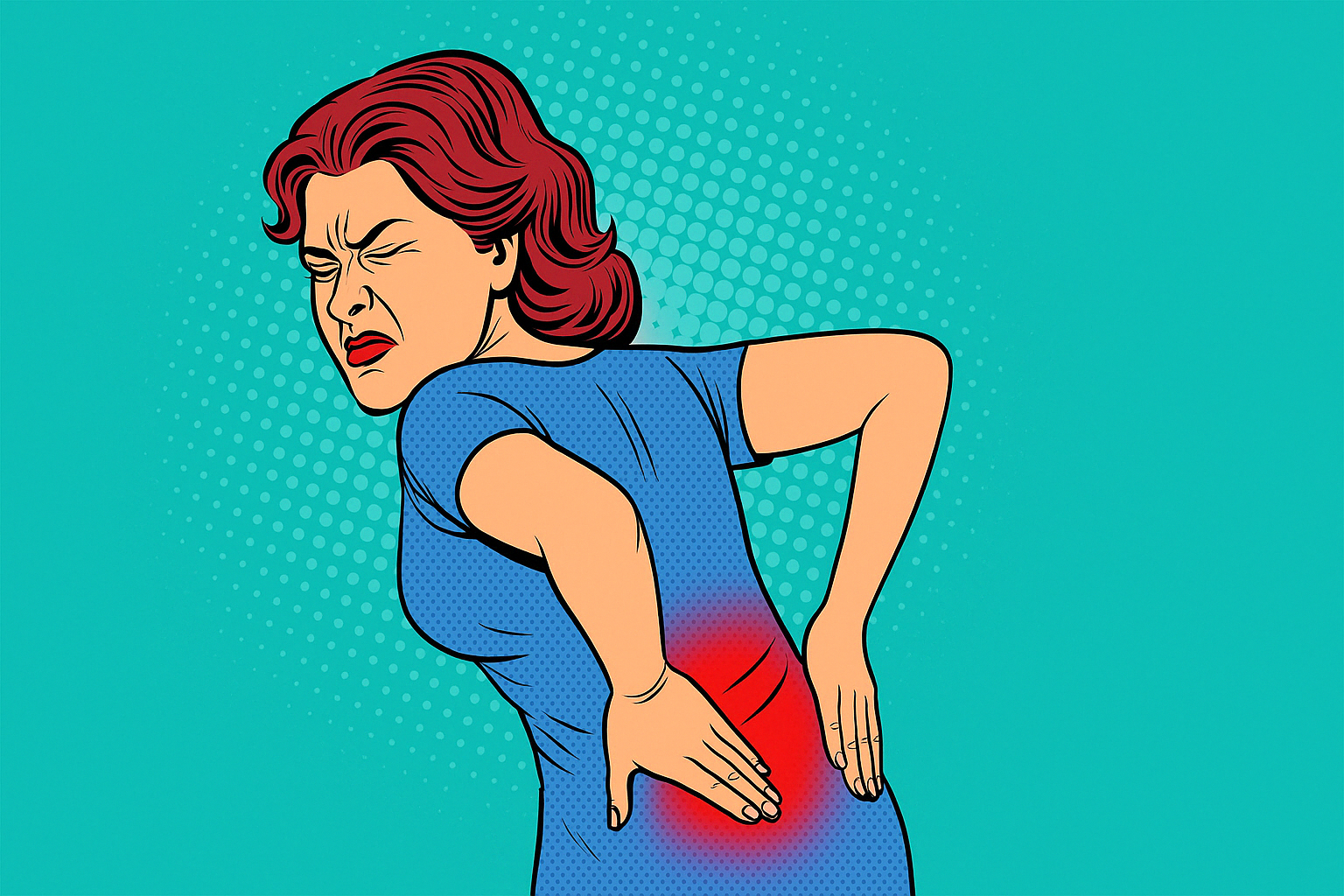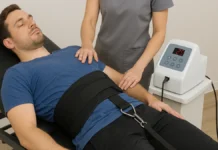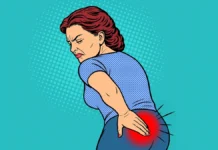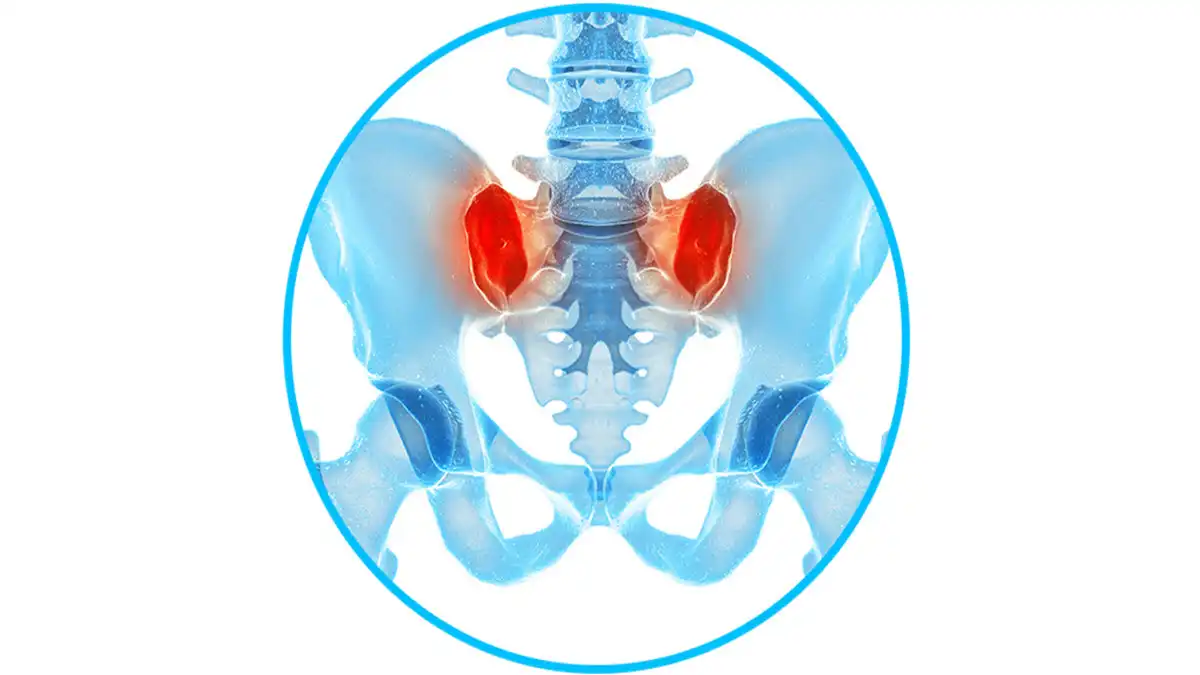Introduction
Gluteus maximus myofascial syndrome is a musculoskeletal condition characterized by the presence of trigger points, also known as trigger points, within the gluteus maximus muscle. This muscle, the largest in the buttock, plays a crucial role in several hip movements, such as extension, abduction and rotation. When subjected to excessive tension, prolonged contractions or repetitive movements, the gluteus maximus can develop hypersensitive and tense areas, known as trigger points.
Trigger points are palpable, sensitive nodules in muscle tissue. They can cause local or radiating pain when stimulated, and the pain may be felt distant from the site of inflammation. In the case of gluteus maximus myofascial syndrome, the pain can radiate to the lower back, the thigh, or even up to the knee.
Triggers for gluteus maximus myofascial syndrome often include strenuous physical activities, prolonged sitting, muscle trauma, or postural imbalances. People who spend long periods of time sitting, such as those who work in an office, may be more likely to develop this condition due to prolonged pressure placed on the gluteus maximus muscle.
Symptoms of gluteus maximus myofascial syndrome can vary from person to person. Some of the common signs include deep pain in the buttock, stiffness or discomfort when walking, and tingling or burning sensations down the thigh. The pain may be made worse by certain activities, such as climbing stairs, walking for long periods of time, or sitting for long periods of time.
The diagnosis of gluteus maximus myofascial syndrome is often based on clinical examination by a healthcare professional. Trigger points can be identified by palpation of the muscle, and patient-reported symptoms help confirm the diagnosis. Additional tests such as X-rays or MRIs can sometimes be used to rule out other possible causes of the pain.
Treatment for gluteus maximus myofascial syndrome generally aims to release muscle tension and reduce inflammation. Approaches may include physical therapy, massage, stretching, trigger point therapy, and the use of relaxation techniques. In some cases, anti-inflammatory medications or topical corticosteroid injections may be recommended to relieve pain and inflammation.
Preventing gluteus maximus myofascial syndrome may involve lifestyle changes, such as taking regular breaks from prolonged sitting, adopting ergonomic postures, and doing regular stretching exercises to maintain flexibility. muscular. A multidisciplinary approach, involving healthcare professionals such as osteopaths and rheumatologists, may be essential for optimal management of this condition.
ATTENtion
A – Insufficient Analysis
Self-diagnosis often relies on a partial or incorrect understanding of symptoms, which can lead to serious errors.
T – Too Much (or Misinterpreted) Information
Avoid relying on unverified or generalized online information, as it can confuse more than it clarifies.
T – Inappropriate Treatment
Be cautious about following inadequate or unnecessary treatments based on an incorrect diagnosis, as this could worsen the situation.
E – Necessary Therapeutic Expertise
It is crucial to consult a qualified healthcare professional for a proper evaluation.
N – Do Not Delay
Delaying proper therapeutic care based on assumptions from self-diagnosis can lead to significant risks.
Do not attempt to use the manual osteopathic techniques described in some articles on the Osteomag website. Only a qualified professional has the necessary skills to apply them safely.
Anatomy of the gluteus maximus
The gluteus maximus, also called the gluteal muscle, is the largest of the gluteal muscles and plays an essential role in hip movements. Its main function is to ensure hip extension, which means that it allows the leg to be straightened backwards when it is bent.
Anatomically, the gluteus maximus has a complex origin. It originates on the posterior surface of the dorsal ilium (the hip bone), the postero-superior iliac crest, the postero-inferior surface of the sacrum and coccyx, as well as on the sacrotuberous ligament. These points of origin extend over the posterior region of the pelvis.
The gluteus maximus muscle then inserts onto the fascia lata, a large sheet of connective tissue that envelops the muscle, at the level of the iliotibial band. The iliotibial band is a fibrous band that runs down the side of the thigh to the knee. Additionally, the gluteus maximus attaches to the gluteal tuberosity of the femur, which is a bony protrusion on the upper part of the thigh bone.
When the gluteus maximus contracts, it exerts force on the femur, causing the hip to extend. This action is crucial in movements such as walking, running, stair climbing, and other activities requiring rearward elevation of the leg.
In addition to its role in hip extension, the gluteus maximus also contributes to other hip movements, such as abduction (spreading the leg out to the side) and external rotation (turning the leg toward the side). ‘outside).
Due to its involvement in several fundamental movements, the gluteus maximus is an essential muscle for hip stability and mobility. Imbalances or dysfunctions of this muscle can contribute to a variety of musculoskeletal problems, including pain in the lower back, hips, and knees. Therefore, its proper functioning is crucial to maintaining healthy biomechanics and preventing hip and lower body related injuries.
Causes
Gluteus maximus myofascial syndrome can be caused by a variety of factors. Here are some of the potential causes:
- Muscle overuse or overload: Excessive use or prolonged contractions of the gluteus maximus, often linked to intense physical activities, can lead to muscle tension and the formation of trigger points.
- Prolonged sitting: People who spend long hours sitting, whether at work or in a sedentary position, may develop muscle tension in the gluteus maximus. This may be due to a sitting position that puts prolonged pressure on the muscle.
- Poor posture: Poor posture, whether sitting or standing, can contribute to muscle imbalances and tension in the gluteus maximus.
- Trauma or injury: Direct trauma, such as a fall on the buttocks, or sports injuries can lead to muscle tension and trigger points in the gluteus maximus.
- Biomechanical dysfunction: Postural problems, muscular imbalances or biomechanical irregularities in walking or running can contribute to gluteus maximus myofascial syndrome.
- Emotional Stress: Emotional stress can cause muscle tension throughout the body, including the gluteus maximus.
- Overweight: Excess weight can put increased pressure on muscles, including the gluteus maximus, which can contribute to the development of trigger points.
- Underlying medical conditions: Certain medical conditions, such as fibromyalgia, may be associated with trigger points and muscle pain, including in the gluteus maximus.
It is important to note that these causes can often be interconnected, and gluteus maximus myofascial syndrome can result from a combination of factors.
Gluteus maximus myofascial syndrome
Trigger point is a central feature of myofascial pain syndrome, a musculoskeletal condition that manifests as tender, tight spots in the affected muscles. This syndrome is often associated with intense local pain as well as referred pain, meaning that pain may be felt distant from the site of stimulation.
Manual trigger point stimulation, usually performed by finger pressure or stretching, is a common diagnostic and therapeutic method. When a trigger point is activated, it not only causes intense pain in the specific location, but it can also generate referred pain in other areas of the body.
Myofascial pain syndrome can have different origins, and muscle trauma is a common cause. However, many other factors can predispose to the development of this condition. For example, unusual physical activity, especially for less active people (such as Sunday athletes), can increase the risk of developing this syndrome. Previous trauma that leads to abnormal muscle function can also contribute to its appearance.
Factors such as inadequate diet, chronic stress, and depression can worsen myofascial pain syndrome symptoms. The gluteus maximus, in particular, appears to be susceptible to this type of pain, which can be exacerbated by high stress levels.
Myofascial pain syndrome of the gluteus maximus is characterized by primary pain in the middle and lower parts of the muscle, which can spread to the buttock and coccygeal region. Patients with this syndrome typically have trigger points on the superior, medial, and inferior aspects of the muscle. These trigger points are specific areas of heightened sensitivity and muscle tension that respond in characteristic ways to manual stimulation.
Accurate diagnosis of myofascial pain syndrome, including gluteus maximus, often requires a thorough clinical evaluation by a qualified healthcare professional. Treatment may include approaches such as physical therapy, manual therapy, stretching, specific exercises, and sometimes the use of relaxation techniques to alleviate stressors.


Myofascial release is a therapeutic technique aimed at releasing tension in the connective tissue (fascia) that surrounds the muscles. Here is a description of the myofascial release technique for treating the gluteus maximus:
Myofascial Release Technique for the Gluteus Maximus:
- Patient Preparation:
- The patient is usually placed in a supine position on the treatment table, on the affected side.
- The therapist explains the procedure to the patient to ensure understanding and comfort.
- Warm-up and Palpation:
- Before release, the therapist may perform a light warm-up by gently massaging the area to improve blood circulation.
- Next, the therapist uses palpation to identify areas of tension, trigger points or restrictions in the gluteus maximus.
- Pressure Application:
- The therapist applies controlled, gentle pressure to identified areas of tension using hands, elbows or specific tools for myofascial release.
- Pressure can be held on each area statically or can be applied with specific movements, following the tension lines of the fascia.
- Gradual release:
- The pressure is maintained until the connective tissue begins to relax. This may take a few minutes.
- The therapist can adjust the pressure based on the patient’s response and how the tissue feels loose.
- Deep Work:
- Depending on the patient’s needs, the therapist can work in depth to reach the deeper layers of fascia and muscle.
- Integration of the Movement:
- To improve effectiveness, the therapist can incorporate patient-specific movements during release, helping to release adhesions and restore mobility.
Goals of Myofascial Release for the Gluteus Maximus
Myofascial release of the gluteus maximus aims to relax and release tension in the fascia surrounding this muscle. Fascia is a connective tissue that wraps around muscles, bones and organs, providing cohesion and structure to the body. Myofascial release can provide several specific benefits to the gluteus maximus, including:
- Reduced muscle tension: Myofascial release can help release excess muscle tension in the gluteus maximus, which can be particularly beneficial for those experiencing pain or stiffness in this area.
- Improved flexibility: By releasing restrictions in the fascia, myofascial release can help increase the flexibility and mobility of the gluteus maximus. This can be helpful in improving athletic performance, range of motion, and quality of daily movement.
- Trigger Point Relief: Myofascial release can target trigger points, also called muscle “knots,” that can cause referred pain in other parts of the body. By releasing these trigger points, myofascial release can help relieve associated pain.
- Improved blood and lymphatic circulation: By releasing fascia restrictions, blood and lymphatic circulation can be improved. This can promote better oxygenation of muscle tissues and accelerate the elimination of metabolic waste.
- Injury Prevention: By working on gluteus maximus flexibility and mobility, myofascial release can help prevent injuries related to muscle stiffness and imbalances.
Exercises and Stretches to Relieve the Gluteus Maximus
Relieving the gluteus maximus can be important to prevent pain and tension in this region. Here are some exercises and stretches that can help you. However, it is always recommended to consult a healthcare professional before beginning a new exercise program, especially if you have any existing health conditions. These exercises and stretches are not suitable for everyone.
Exercises to strengthen the gluteus maximus:
- The slots:
- Stand with your feet shoulder-width apart.
- Take a big step forward with one leg, bending both knees to form two 90-degree angles.
- Return to the starting position and repeat with the other leg.
- Squats:
- Stand with your feet shoulder-width apart.
- Come down by bending your knees and pushing your hips back as if you were sitting in a chair.
- Slowly return to the starting position.
- Lateral leg raises:
- Lie on your side, supported by your elbow.
- Lift your top leg up, then slowly lower back down.
- Repeat on the other side.
Stretches for the gluteus maximus:
- Pigeon stretch:
- Sit with one leg bent in front of you and the other leg extended behind you.
- Lean forward on the bent leg, keeping your back straight.
- Hold the position for 15-30 seconds and repeat on the other side.
- Quadriceps stretch:
- Stand and bend one leg, grabbing your ankle with your hand on the same side.
- Gently pull your heel toward your butt while maintaining balance.
- Hold the position for 15-30 seconds and repeat on the other side.
- Seated Hamstring Stretch:
- Sit on the floor with your legs apart.
- Lean forward while keeping your back straight, trying to reach your feet.
- Hold the position for 15-30 seconds.
These exercises and stretches can help relieve tension in the gluteus maximus. Make sure you perform them with proper technique and in a controlled manner. If you experience abnormal pain while performing these exercises, stop immediately and consult a healthcare professional.
Conclusion
In conclusion, gluteus maximus myofascial pain syndrome is a musculoskeletal condition characterized by the presence of trigger points in this important muscle. These trigger points, when manually stimulated, not only generate intense pain locally, but also cause referred pain in other parts of the body. Although muscle trauma is often associated with this condition, other factors such as unusual physical activities, previous trauma, dietary imbalances, chronic stress and depression can contribute to its development.
The gluteus maximus, due to its sensitivity to myofascial pain, can be particularly affected, causing localized pain in the middle and lower parts of the muscle, as well as pain radiating to the buttock and coccygeal region. Trigger points are often located on the upper, medial and lower sides of the muscle, creating hypersensitive areas.
Treatment of gluteus maximus myofascial pain syndrome typically involves multidisciplinary approaches, such as physical therapy, manual therapy, specific stretches, and tailored exercises. Managing stressors, a balanced diet, and a holistic approach to physical and mental health are also important in the treatment process.
It is essential to consult a healthcare professional for an accurate diagnosis and treatment recommendations tailored to each individual. Understanding the mechanisms underlying gluteus maximus myofascial pain syndrome allows for a more targeted approach to alleviating pain, restoring normal muscle function, and improving the quality of life of those affected by this condition.

























